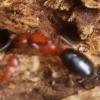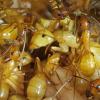TL:DR - I have a large Camponotus decipiens colony in a log I found. They either have to be captured or they will burn with the log. The log is in a 20 gallon aquarium. What would be less risky to the queen and colony: Peeling apart the log with some tools or slowly flooding the aquarium over many hours?
Some of y'all may have read my post about my first colony, a Camponotus decipiens colony, I found in a small log on our burn pile. Well... It happened again. This time a much bigger log. I put this log on the burn pile, I am still helping clean up the parents property. It is a 12 inch or bigger rotten log. I saw lots of termites in it when I moved it. I collected some to feed to my ants and thought nothing of it again. That was till the next day when I noticed a bunch of saw dust piled up right outside the log. After investigating I saw a couple of Camponotus decipiens workers go into the log where a limb must of been at one time.
Well, I can't just leave this log laying around and I don't want these ants to burn up, so I figure it is rotten I'll just peel it apart and collect the ants. The termites can be food! Win / win. I was thinking it would be no bigger than the colony I found before, 50 or so workers. I really thought it was a brand new colony just established last year or this year. I was wrong. This is a big colony, easily over a 100 workers, lots and lots of majors. I spent probably two hours trying to get them all out. The middle of the log where most of them are, and the queen I am guessing, is still pretty solid. It looks like the termites have been kicked out or eaten, I found very few.
After all that work I had the log down to a size that it would fit in an 20 gallon aquarium. I put it in there with a baby powder barrier. I can continue to peel apart the log, but I am going to have to use some tools to make progress and I am afraid of killing the one ant I can't kill: the queen.
I was wondering if y'all thought if I slowly flooded the aquarium, say over a period of 8 hours, if they would move out on their own? A hose with a very slow drip is what I was thinking. I would leave a tube leading from the log to another aquarium with pieces of the log they can hide in but I can easily just flip over later to expose them and motivate them to move into a formicarium. Should I attempt this or just try to carefully continue to peel the log apart? Do you think the chance of the queen and much of the colony drowning is a bigger risk than if I just kept peeling the log apart?
For all the people screaming about why am I collecting wild colonies, it literally is either this or death for them. I could just leave the log somewhere but eventually my parents would throw it on the burn pile or in the trash when I'm not around. They want to clean the place up, not leave a few logs laying around because I like ants. :-P I will also put their out world outside when they produce alates, so that they may continue to contribute to their species.
I don't know why I never noticed all these interesting ants around here when I was growing up. I know the location of five separate Camponotus decipiens colonies now. Those ones are safe in living trees or dead wood that is part of the fence line. I also realized two of the colonies I discovered were actually acrobat ants, Crematogaster laeviuscula maybe? They have the same coloration as Camponotus decipiens which is why at first I thought that was what they were. I soon realized they were not after actually inspecting them, very different shape and behavior but same favored nesting areas. That makes seven big colonies I of interesting ants I found out in the last few months. I often also see very tiny black ants in the wood, but I have not investigated them further.
Anyways, as much as I loved nature growing up, especially the arthropods, I am just surprised I never took more notice of these ants.
Please let me know if you have a suggestion about how I could go about getting the colony I spoke of out of that dang log. Thanks for reading!
Edited by dominatus, June 13 2019 - 9:10 PM.
















